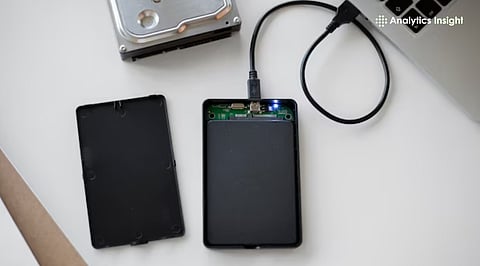

A SATA SSD upgrade is the easiest way to revive an old desktop, delivering faster boot times, quicker file access, and smoother performance without replacing the motherboard.
Drives like Samsung 870 EVO and Crucial MX500 stand out for speed, reliability, and endurance, while models like the 870 QVO or BX500 offer excellent value for budget upgrades.
Even with newer NVMe drives available, SATA SSDs remain the best balance of compatibility and performance for extending the life of legacy systems.
Desktops approaching end-of-life cycles can regain efficiency through a single upgrade. Replacing mechanical drives with SATA solid-state technology removes latency and throughput limitations common in day-to-day workloads. Startup, application loading, and data transfers all become markedly faster.
Compatibility is seamless, requiring no motherboard updates or hardware tuning. Operating quietly and efficiently, SATA SSDs deliver lasting value through speed, stability, and energy conservation. Let’s take a look at the measurable gains this upgrade introduces in consistent performance and user experience.
At speeds reaching 6 Gbps, SATA III pushes data through at roughly 550 MB/s under load. NVMe may lead the performance race, yet SATA continues to anchor legacy and business machines where reliability outweighs speed. Its near-universal compatibility allows deployment across older boards without technical modifications.
Designed for stable operation and low energy draw, it continues to offer smooth, dependable performance. When value and consistency dictate buying decisions, SATA SSDs still provide unmatched practicality.
Samsung 870 EVO’s reads hit 560 MB/s and writes stay steady near 530 MB/s. This model drives the interface to its full capacity. The integration of V-NAND flash memory and the MKX controller enhances both energy efficiency and write endurance. Advanced management utilities and a five-year limited warranty mark it as a benchmark choice for main storage operations.
QLC NAND allows very large sizes at friendly prices. Capacities stretch to 8 TB, perfect for photo and video collections or long archives. Sequential speeds remain close to the SATA ceiling thanks to a dynamic SLC cache.
Endurance sits below TLC drives, but for mostly read-heavy libraries, this tradeoff favors value. Samsung’s refined controller and optimized firmware maintain smooth access even under high-capacity workloads, ensuring reliable operation for extensive storage needs.
Designed for continuous, heavy access, this drive handles sustained transfers without sudden slowdowns. With 2.5-inch and M.2 SATA configurations, the drive accommodates diverse hardware designs. It excels in roles demanding uninterrupted accessibility and balanced throughput across long runtimes.
A 3.5-inch adapter might be needed for older tower bays. It also has optimized firmware tuned for NAS workloads, ensuring better endurance, faster caching, and reliable multi-user data handling across 24/7 operations.
A mature design that emphasizes steady performance and simple migration. Bundled cloning tools remove migration headaches. Capacity options up to 4 TB cover office, school, and light creative work.
Reliability and straightforward installation make this a practical pick for most legacy systems. Equipped with advanced flash management and low power draw, the drive maintains consistent speeds while extending lifespan under continuous daily use.
860 QVO is an earlier QLC model that still delivers solid value. Read speeds approach 550 MB/s, while Intelligent TurboWrite keeps short bursts quick. Good for large multimedia storage and backups.
Hardware encryption and Opal support add data protection where needed. Endurance ratings remain competitive for its class, and firmware optimization ensures consistent performance even as the drive reaches higher fill levels.
Micron’s 3D TLC NAND powers a balanced performer. Strong read/write numbers across capacities and low power consumption suit compact or older builds. Hardware AES encryption and Microsoft eDrive support ease secure setups.
With a solid five-year warranty, this drive promises lasting reliability. Its clever thermal control and data protection hardware help minimize slowdowns and prevent losses during intense system activity.
Compared to spinning hard drives, this model delivers instant boots, sharper system response, and shorter wait times with every click. BX500 avoids superfluous features yet achieves precisely what a budget system needs: speed and dependability.
A single afternoon spent swapping in the right SATA SSD returns daily benefits for years. Faster startups, quieter operation, and smoother multitasking transform the feel of an older desktop.
For those wanting a real upgrade without rebuilding the whole machine, focus on storage first. Users should choose according to endurance needs and storage size requirements to ensure optimal functionality.
1. What makes a SATA SSD better than a traditional hard drive?
A SATA SSD has no moving parts, allowing faster boot times, quicker file transfers, and quieter operation. It also uses less power and is more durable than mechanical hard drives.
2. Can older desktops support SATA SSDs?
Yes. Most desktops built in the last 15 years include SATA ports. As long as the system supports SATA II or SATA III, an SSD can be installed without additional hardware changes.
3. Is there a noticeable difference between SATA II and SATA III performance?
SATA III provides higher throughput (6 Gbps), enabling SSDs to reach full potential speeds of around 550 MB/s. SATA II still works but limits speed to roughly half that rate.
4. Which SATA SSD is best for everyday use?
The Samsung 870 EVO and Crucial MX500 stand out for consistent performance, endurance, and reliability, making them excellent choices for daily computing.
5. Is it worth upgrading to a SATA SSD if NVMe drives are faster?
Yes. While NVMe drives are faster, many older desktops lack M.2 slots or PCIe support. SATA SSDs offer the best upgrade path for legacy systems without compatibility issues.
